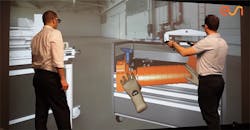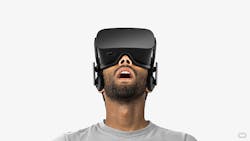Virtual Reality Marketing Already Helping Manufacturers
A syringe-making machine built by Stevanato Group SpA of Italy runs 23 hours a day, churning out glass needles that can be filled with blood thinners, vaccines or cancer treatments. It weighs 7 tons, making it hard to lug along on marketing trips.
The family-owned company, based near Venice, solved that problem by hiring Interpublic Group’s R/GA London advertising agency, which built a virtual reality program that lets potential clients don headsets and take a simulated walk into the machine to see it whir and spin as the syringes are assembled.
“Now it’s like carrying the machine with us,’’ said Christophe Bureau, vice president for strategic innovation at Stevanato.
As the price of virtual reality headsets like Facebook Inc.’s Oculus Rift and Samsung Electronics Co.’s Gear VR falls, advertising is embracing the technology to sell everything from airline tickets to beer. BMW AG and Volvo AB have created apps that let users simulate driving their automobiles and Ikea of Sweden AB released a program that builds a virtual kitchen.
Cannes Debut
Google Inc.’s Cardboard, a low-cost virtual reality viewer that works with smartphones, has inspired other new marketing techniques. Coca-Cola Co. and McDonald’s Corp. let customers fashion virtual-reality goggles from soda-can packaging and Happy Meal boxes.
“People don’t believe and trust in broadcast ads like we used to,’’ said Victoria Buchanan, creative director at ad agency Tribal Worldwide, part of Omnicom Group Inc. “People want to try before they buy or feel before they touch. This is going to be vital in getting people engaged.’’
With sales of virtual reality headsets and software expected to reach $1 billion this year, the technology is a focus of the Cannes Lions International Festival of Creativity, an annual gathering of advertisers and agencies this week on the French Riviera.
Executives of Alphabet Inc.’s Google, which is set to introduce a virtual reality platform based on the Android mobile operating system this year, are scheduled to speak about the technology. Ad agencies will discuss how they are using it to promote brands and products.
Google’s YouTube video-sharing service has created a channel for clips filmed in 360 degrees, and brands like Gatorade, Mini USA and Nike have posted films on it. Facebook lets users view and upload 360-degree photos.
“We’ve been working with brands on how to create access points to virtual reality via Cardboard,’’ said Debbie Weinstein, Google’s chief of brand solutions and innovations for Europe, the Middle East and Africa. “We’re encouraging people to start with the 360 video or a GoPro camera,” which can be mounted on sports helmets for action videos.
Immersv, a virtual reality ad network based in Los Angeles, has developed a service that sells advertising around virtual reality clips. The company started it in beta mode in March and more than 30 program creators are using the technology in apps, said Brian Roth, vice president of sales at Immersv.
Adoption Barriers
Despite the strides, virtual reality remains a fringe advertising technique. Though the Oculus Rift has dropped to around $600, the cost of a headset is a barrier, and production costs are high. The experience of surrounding users with video and sound can also leave some feeling isolated, rather than connected.
“Right now virtual reality is an exclusive experience, because of the hardware, and putting it over your head limits you from being social with it,’’ said Sol Ghafoor, head of digital strategy at Publicis U.K. in London. “Once physical barriers are overcome you will see it become mainstream, beyond games.’’
High costs haven’t stopped some luxury marketers from dabbling in the technology. Etihad Airways last month released a virtual reality film starring Nicole Kidman to promote first-class flights on its Airbus Group SE A380 planes. The four-minute film took a 360-degree view of the jetliner’s inside, in which viewers see Kidman rehearsing script lines, speaking on the telephone and wandering around the cabin.
“We chose virtual reality because the strength is you can feel present in a time and space you wouldn’t otherwise be in,’’ said Ola Bjorling, global head of virtual reality at ad agency MediaMonks, which developed the Etihad film. “Virtual reality right now isn’t going to sell ketchup, but if you’re Lamborghini, people will seek it out.’’

